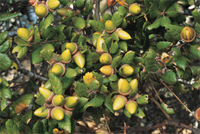In 1934, eminent naturalist Joseph Grinnell sat by the lower Kaweah River in southern Tulare County, watching bright blue western scrub-jays zoom uphill. Each beak held a single acorn, plucked from the bounteous blue oaks along the riverbank, to be cached in the dry upland hills. All day long, jays repeated this journey, flying uphill with an acorn, returning, as Grinnell described it, “empty-billed.”
Previously, climbing the western slope of the southern Sierra Nevada, Grinnell had observed a rich crop of black oak acorns dropping from the trees, tumbling down the mountain, round, smooth, and heavy. “In that place and on that day I saw no acorn moving uphill. Gravity alone was acting as the agency of distribution.” Without animal help, such as that provided by the western scrub-jay, acorn woodpecker, chipmunk, gray squirrel, or ground squirrel, our upland forests, woodlands, savannas, and scrub-oak chaparral, would not exist as they do today, or, when burned in the inevitable fires, would not be replaced. On that day by the river, Grinnell understood something that had been unclear to him until then: the role of the western scrub-jay in the landscaping of California.
Grinnell’s reflections, which may seem obvious to us now, were not commonly understood in his day. Only 11 years before, another well-known ornithologist, William Dawson, in his classic Birds of California, called this critical ecological role a minor function of the jay. “Doubtless,” he wrote, “this miserly trick (of burying acorns) has served nature’s purpose now and then in producing new trees.” To the native peoples of California, the importance of the jay’s role has been apparent for a longer time. According to C. Hart Merriam, “The Middle Mewuk of [the] Stanislaus River region say: Ki-ki-ah, the Crested Bluejay of the mountains [Steller’s jay], plants acorns so that oak trees come up almost everywhere. (Several other tribes mention the same habit, which, by the way, is hardly a myth.)”
In my own West Marin garden, I’ve enjoyed the results of scrub-jay seed-planting for 21 years. Of the nine coast live oaks now growing here, I take credit for the planting of only three; Aphelocoma californica, the western scrub-jay, accounts for the rest. California hazel as well turns up far from the parent shrub, frequently in the hospitable embrace of coyote bush. Coffeeberry, California bay laurel, and California black walnut are other species I find growing here and there. Like acorns, their seeds are too large to be moved by ants and too dense to be carried by the wind. Just a short way inland from here, the acorn woodpecker might be responsible, or the chipmunk, grey squirrel, and ground squirrel. Other animals engaging in caching behavior in California include chickarees, wood rats, Steller’s jays, and band-tailed pigeons. Here, on this marine terrace, scrub-jays — which range all over the West south of Oregon — are the primary tree planters, acting out of an implacable desire to bury things, paired with the ability and necessity only sometimes to retrieve them.
The trees and shrubs that grow from the seeds that the western scrub-jay caches in my garden are generally allowed to stay in place. I like to think that in so doing, I am honoring the landscaping ideas of jays. This concept is a device, a way of thinking about a kind of gardening that helps us become aware of the actions, needs, and impact of butterflies, deer, ants, bees, jays, and numerous other wild creatures, who can become, in a sense, our gardening partners.
- Coast live oak acorns, dense and relatively heavy, can’t bemoved by the wind. That means they either roll downhill or gettransported by jays and other animals. Photo by Charles Kennard.
Western scrub-jays need to be good but not too good at acorn retrieval. The more acorns and nuts they cache and the fewer they retrieve, the better for the spread of oaks, hazelnuts, walnuts, and various pine trees. Yet they must be able to retrieve enough to maintain viable populations, to feed themselves during lean times. The mechanisms of retrieval of stored food for western scrub-jays, as well as for several other species of corvids, have been the subject of many ornithological studies since Dawson and Grinnell pondered these matters. Ornithologists credit scrub-jays with only moderate success in seed retrieval. They are not geniuses at it, like their corvid cousins, the Clark’s nutcracker and the pinyon jay. Clark’s nutcracker, as described in Ronald Lanner’s book Made for Each Other, relies heavily though not totally on the nuts produced by the white-barked pine, Pinus albicaulis, which returns the compliment by being utterly dependent on Clark’s nutcracker to open its tough and unyielding cones and bury the seed in appropriate places. One bird can cache as many as 98,000 seeds in more than 30,000 caches in a year. These birds have dazzled researchers with their uncanny memories, locating specific cracks and crevices where nuts were stored up to ten months previously. The nutcracker is reputed to move up to 55,000 of these wingless, gravity-bound seeds per month, and to recover and eat only half of them. The rest have a good chance of germinating when summer melts the snow and raises temperatures. Says Lanner, “Working in concert, Clark’s nutcracker and the white-barked pine build ecosystems.”
Western scrub-jays, like Clark’s nutcrackers, use landmarks, such as trees and rocks, to find cached food, and the sun as a compass by which to orient themselves. Experiments have shown that scrub-jays have memory of where food is stored, when it was stored, which stored items have been retrieved, and what kind of food item is stored. Individual scrub-jays that have pilfered the caches of other scrub-jays even demonstrate awareness that they themselves are being watched while hiding acorns. Waiting till the observer goes away, they then rehide the nuts elsewhere. All of which implies the sophisticated ability to understand that “what I have done unto you (rifling your cache), so might you do unto me.” Innocent scrub-jays that have not engaged in pilfering behavior do not as a rule re-cache.
In one well-known and oft-cited experiment seeking to measure acorn retrieval success, a graduate student was pitted against a Clark’s nutcracker. While the nutcracker and the student watched, acorns were hidden all over the laboratory. During retrieval, the graduate student performed less than half as well as the bird.
In all fairness, it should be noted that the bird had considerably more “reason to know” than the graduate student, to whom the acorns were of only academic interest. If the search object were the keys to a Mercedes, or a contract for a tenured position at Harvard, the graduate student might have shone, and the camp robber put in a lackluster performance. For the corvid, each accurate retrieval is inextricable from relief from hunger and the password to living another day, to squawk at a dog, chase cats, or sneak into a covey of quail to pretend he is one of them for a while.

- At backyard feeders, western scrub-jays have a reputationfor being aggressive and domineering birds, though some experts saythis might be because feeders attract abnormal concentrations of jays.The birds also stash countless acorns, as well as lizards, insects, andthe seeds of other plants, for later meals. Photo by William Hinshaw.
Western scrub-jays don’t need to be as good at caching as Clark’s nutcrackers, who live in more extreme climates. The Bay Area and other similarly moderate climates provide western scrub-jays with many other things they like to eat throughout the year, including insects, lizards, apples and pears, seeds of all kinds, waxworms (a particular favorite), cookies, bay nuts, bird feed, spiders, earwigs, cicadas, snakes and salamanders, elderberries, gooseberries, dog food, cat food, cattle feed, and, yes, the eggs and babies of other birds. The western scrub-jay’s diet also includes ticks, which are reportedly removed directly from the backs of mule deer and black-tailed deer, who “facilitate [the] activity by standing still and erect, with ears raised,” according to the western scrub-jay life-history volume published as part of the The Birds of North America series.
Though the western scrub-jay is significantly responsible for our oak- and pine-studded hillsides, the bird does not arouse only gratitude. In 1923, William Dawson had quite a bit to say about the jay’s dualistic nature: “He, the malaprop, the impertinent, the sly wag, thief, scoundrel, outcast, jackal of the bush — as innocent as morning, as industrious as noon, as wicked as night.” Dawson calculated the number of bird eggs the jay may be responsible for eating and wondered that nature can absorb such predations. Because of the jays’ interest in the eggs and young of other birds, Dawson claimed that the jay is “undoubtedly the chief biological control factor in the distribution of bird life throughout the area specified.”
Tom Gardali of PRBO Conservation Science (formerly the Point Reyes Bird Observatory) in West Marin has a more up-to-date assessment. “This is likely not so,” he says. “Most nest camera studies show that corvids are relatively minor nest predators — snakes seem to be the stars.” Still, jays are stunningly observant, and, according to Gardali, can learn to spot and follow an ornithologist on the way to study a bird nest, in anticipation of a tasty bird egg or baby bird treat. Researchers at PRBO have learned to head off to study sites only after making certain they are not being spied on by a scrub-jay.
Geoffrey Geupel, director of the Terrestrial Ecology Division of PRBO, contends that it is in the venue of the backyard bird feeder that jays exhibit so much of the behavior that bird-watchers dislike. (In general, Geupel is not a fan of the bird feeder. “Use the money you would otherwise spend on birdseed and bird feeders to restore habitat,” he says.) Indeed, I recommended to several clients who complained to me about jay behavior that they eliminate their feeders and focus instead on appropriate native plantings; it seems to work. Using bird feeders with openings and perches too small for scrub-jay use is also effective. Open compost piles are another jay attractant that can encourage out-of-balance populations of jays, as well as crows and ravens. Gardali says, “Jays and other corvids only really have the potential to be a problem when their populations are subsidized to the extent that they grow beyond normal levels. Subsidies include a solid food supply (for example, feeders) during times when food would naturally be scarce (winter). Or more food during the breeding season could lead to large clutch size and double brooding.”
Jay hunts organized in the 1930s, for the ostensible pu”pose of retaining high quail populations, are another example of historic prejudice against scrub-jays. Yet I frequently find scrub-jays in the middle of quail flocks, peaceably foraging for seeds and insects. Native peoples knew the scrub-jay as a thief, but also as a watchdog, who let no intruder appear without warning. When the quail covey is disturbed and scatters, the jay flies to a nearby tree, screlching indignantly on behalf of his friends. When I put acorns out for the quail, they leave them untouched until the jays come along. Using horizontal branches as anvils, the jays are able to crack the nuts open, and the otherwise inaccessible nutmeat that they inadvertently drop or leave behind becomes available to the quail waiting nearby.
In my garden, I will always remember which trees were transplanted from containers into the ground and which had the luck to grow from acorns planted directly in the ground by the beak of a cheeky corvid, whose apparent intention was to return for a later snack. I honor these planting choices partly because trees planted directly in the ground by jays have a different and probably healthier trajectory through time than the ones that begin their lives in nursery containers, to be subsequently transplanted into the ground with some degree of care and coddling. Trees that grow from acorns planted directly in the ground, pounded in by the jay’s sturdy beak, their roots never for a single moment confined by a container, have a significant advantage. Once, that is, they make it past the seedling stage. Acorns in the ground are vulnerable to many kinds of hazards, from rot and mold to weevil attack and, of course, retrieval by squirrels and other rodents as well as by the jays themselves.
Relinquishing a bit of design control to these perspicacious birds may be appropriate for other situations besides gardens. In many landscape restoration projects, acorns are harvested, hauled from collecting grounds, cleaned, refrigerated, taken to the planting field, sown in the ground, and protected with screens and tubes from deer above and gophers below. Perhaps time and effort might be saved, however, if the acorns were left in a huge pile near the area to be restored. It might not be long until, like an Andy Goldsworthy sculpture of twigs and stones borne out by the tide, a river of birds pours down from the sky to deconstruct the pile and find for each acorn a likely resting place. A bird- and oak-lover in Modesto, living in what was once the floodplain of the Tuolumne River, put out hundreds of valley oak acorns for the local scrub-jays. In the course of three days, dozens were removed and cached all around her house, garden, and neighborhood, in loose soil, leafy debris, roof tiles, gutters, and planter boxes. Across from her house, a lone oak, the source of this bounty, is silhouetted against the western sky, the last survivor of what was once a dense riparian forest. Given a chance, the western scrub-jay could return the original vegetation, shade the houses that now bake in the summer heat, and relandscape the neighborhood.
Such a project would also provide an opportunity for what Cornell Ornithological Laboratories calls “citizen science,” which I practiced myself one day while cleaning seeds in our seed room with the door open. Spotting a bowl of coast live oak acorns, a jay swooped into the dim cool room, grabbed an acorn, and left with it. Thirty consecutive trips to the seed bowl followed, as 30 acorns were removed, one by one, from the bowl. (Unlike Clark’s nutcracker, the scrub-jay can only carry one acorn at a time.) My presence, three feet away from the bowl, did not deter him. Our unplanned experiment lasted for about an hour, with about two minutes between raids, presumably for caching nearby. Somehow he knew it was worth checking out the seed room that fall day.
Covering the tray with a cloth, I waited for the jay’s return, curious to see if he would employ complex retrieval behavior in my presence. He assessed the situation, then left, returning three minutes later to see if things had improved. When I pulled back a bit of the cloth so that some of the acorns were in view, he grabbed one of the visible nuts, and left. Covering the bowl again, I waited to see if he would pull the cloth back himself, but apparently this activity required too much time in my presence. Even for the cocky jay, this proximity pushed the comfort zone.
In my weakness for jay-planted oaks, I often, in the early years of my garden, let them stay where they were, though they have since turned a greenhouse into a shade house and kept a new addition small. Sometimes, I find advantages later that were not at first apparent. One jay-planted oak nicely frames my garden; another provides a nighttime roosting site for quail so that their nocturnal cooings and rustlings can be heard from a bedroom window. I didn’t anticipate these pleasant consequences. As Dawson said, “the jay was right, after all, and I apologized.” In this way, my design decisions are aided and abetted by the creatures that share this territory.
Perched at the top of one of the trees planted by an ancestor, weeping, screlching, zeeping, zraanhing, rattling, chukking, or shlenking, the jay encourages me to continue to consider his landscaping ideas. I regard each small seedling, whether an oak, California hazel, bay, or coffeeberry, as something more than itself, a proof of continuance of a partnership, not at all trivial, still at work.

.jpg)




